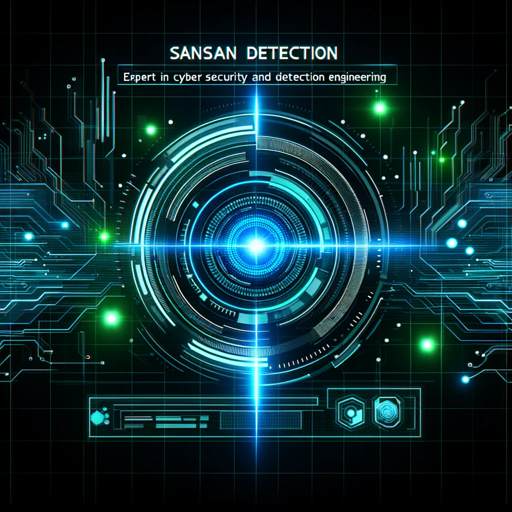Security Onion Sage-AI assistant for Security Onion
AI-powered security assistant for experts
How do I set up Security Onion?
Explain the features of Security Onion.
Troubleshooting tips for Security Onion?
Best practices for Security Onion deployment?
Related Tools
Load More
Red Team Guide
Red Team Recipe and Guide for Fun & Profit.

Security Architect
An experienced security architect with over 20 years in security across all technology domains.

SOC Security Analyst
Analyzes security Payload for threats vs. false positives

Selenium Sage
Expert in Selenium test automation, providing practical advice and solutions.

Cyber Threat Hunting and Detection Engineering
Expert in detection engineering, threat hunting, Sigma and Yara rules creation.

Red Cell
Expert hacker and social engineer to assist cyber security professionals.
20.0 / 5 (200 votes)
Introduction to Security Onion Sage
Security Onion Sage is a comprehensive, open-source platform designed for network security monitoring, intrusion detection, and log management. Built primarily for defenders by defenders, its primary function is to deliver complete network and host visibility using tools such as Suricata, Zeek, and Strelka for network data, and Elastic Agent for endpoint telemetry. It offers real-time alerting, dashboards, hunting tools, and case management through its Security Onion Console (SOC). Security Onion Sage excels at combining both network-based detection and host-based data into a unified, analyzable format. For example, network analysts can detect lateral movement in a network by integrating Suricata’s intrusion detection alerts with host-based logs from Elastic Agent, all through SOC’s dashboards and hunt interface.

Main Functions of Security Onion Sage
Intrusion Detection System (IDS)
Example
Suricata generates real-time NIDS alerts when it detects malicious traffic based on predefined signatures.
Scenario
In a corporate network, Security Onion Sage monitors inbound traffic to detect potential exploits or malware downloads by analyzing packet data. The alerts generated by Suricata help analysts identify these threats in real-time.
Packet Capture (PCAP)
Example
Stenographer records full packet captures of all network traffic, allowing for deeper investigation into incidents.
Scenario
If an analyst identifies suspicious activity through Zeek or Suricata alerts, they can retrieve full packet capture data from Stenographer to review the exact traffic flow, source, and payloads to confirm if data exfiltration or other malicious activity occurred.
Host-Based Detection and Telemetry
Example
Elastic Agent collects endpoint logs and enables live queries with osquery for real-time system state interrogation.
Scenario
A Security Operations Center (SOC) can deploy Elastic Agent across enterprise endpoints. In case of a detected lateral movement on the network, the agent logs could show unusual process starts or file modifications, helping analysts correlate endpoint behavior with network-based alerts.
Ideal Users of Security Onion Sage
Security Operations Centers (SOCs)
SOCs benefit the most from Security Onion Sage, as it provides centralized logging, alerting, and analysis tools for both network and host-based events. SOC teams can efficiently triage and respond to security incidents using the platform's tools, such as alerts, dashboards, and packet captures, which allow for swift detection and investigation of potential threats.
Incident Response Teams
Incident response teams can leverage Security Onion Sage’s capabilities for real-time detection and retrospective analysis. By using tools like Strelka for file analysis and full packet capture capabilities, these teams can deeply investigate breaches, reconstruct attack chains, and determine how a network was compromised.

Steps to Use Security Onion Sage
Visit aichatonline.org
Go to aichatonline.org for a free trial of Security Onion Sage without needing to log in or have a ChatGPT Plus subscription.
Prepare your system
Ensure you have a Security Onion setup, which may include network sensors and log monitoring based on your requirements. Refer to the official Security Onion documentation for hardware and deployment needs.
Install and configure Security Onion
Follow the guidelines for downloading, installing, and configuring Security Onion to ensure proper detection and logging capabilities. Common configurations include managing IP addresses, setting up SOC, and configuring Elasticsearch.
Access Security Onion Console (SOC)
Login to the SOC dashboard for alert management, threat hunting, and case management. Integrate tools like Suricata and Zeek for detailed network visibility and log correlation.
Fine-tune performance
For optimal results, adjust firewall, proxy settings, and high-performance tuning as per your environment's traffic load. Refer to tuning options in the documentation.
Try other advanced and practical GPTs
Invest Real Estate
AI-Powered Real Estate Investment Insights.

Invest like George SorosAI
AI-powered insights inspired by Soros’ strategies.

Voice Over From Text
Transform Text into Engaging Audio with AI

支語檢察長(支檢長)
AI-Powered Language Assistant for Precision and Clarity

Voice Over
AI-driven voice-over creation made easy

Ink Painting - 水墨画
AI-Powered Traditional Ink Painting Tool

Software Arc
AI-driven insights for software architecture.

Software Architect
AI-Powered Software Architecture Tool

Nuclear Simulations Whiz
AI-powered guidance for nuclear simulations.

*Pro* Academic Research Paper Proof Reader
Enhance Your Academic Writing with AI-Powered Precision.

Proof Reader
Enhance Your Writing with AI Precision

GPT Jailbreak-proof
AI-powered, jailbreak-proof assistance for safe creativity.

- Security Monitoring
- Threat Hunting
- Intrusion Detection
- Network Visibility
- Log Management
Common Questions about Security Onion Sage
What is Security Onion Sage?
Security Onion Sage is an AI-powered assistant that helps users deploy, configure, and optimize Security Onion. It provides in-depth guidance on network security monitoring, intrusion detection, and log management, integrating knowledge from Security Onion’s documentation.
What are the primary use cases for Security Onion?
Security Onion is used for network security monitoring, intrusion detection, threat hunting, log management, and case management. It’s popular among enterprises for managing network visibility, and also in educational environments for cybersecurity training.
How does Security Onion integrate with other tools?
Security Onion integrates with tools like Zeek, Suricata, and Strelka for network and file analysis, as well as Elastic Stack for log storage and visualization. It also offers CyberChef for artifact analysis.
What type of deployment setups are available in Security Onion?
Security Onion offers several deployment setups: Import, Evaluation, Standalone, and Distributed. These vary based on the network size, traffic volume, and resource availability.
How do I manage alerts in Security Onion?
Use the SOC console’s Alerts interface to review, acknowledge, and manage network intrusion detection system (NIDS) alerts. Suricata-generated alerts can be correlated with network metadata from Zeek for detailed analysis.